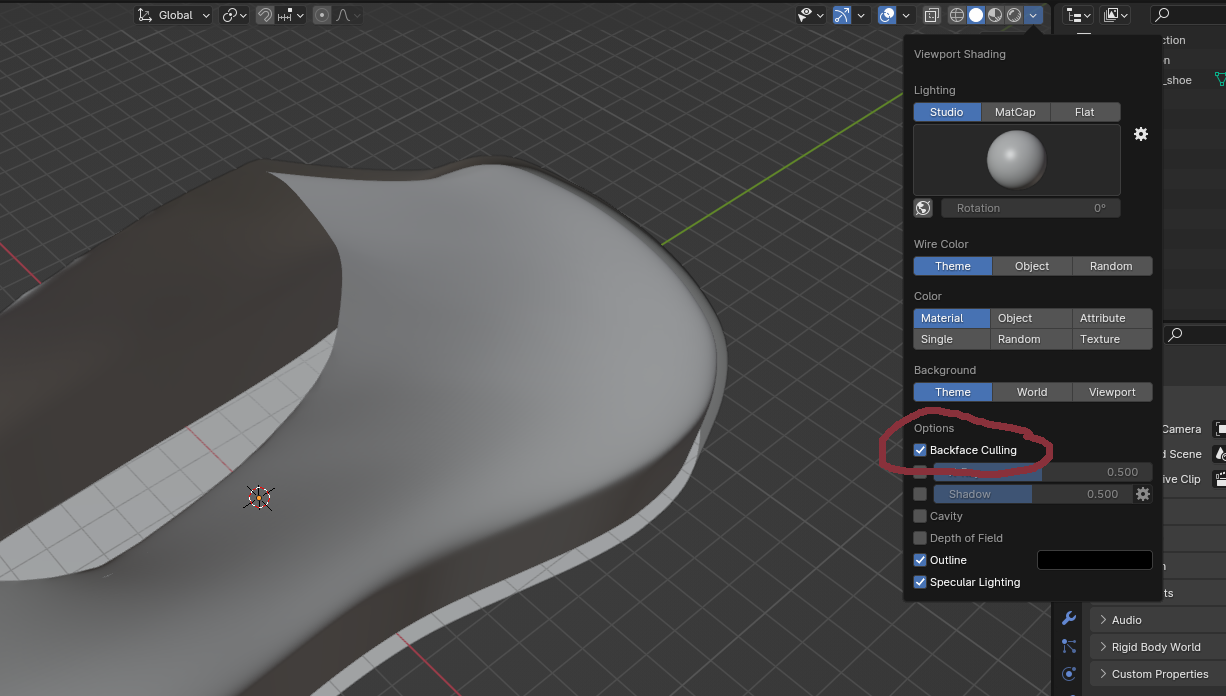Really, Penfold.
I once met a person that never drank water, only soft drinks. It’s not the unhealthiness of this that disturbed me, but the fact they did it without the requisite paperwork.
Unlike those disorganised people I have a formal waiver. I primarily drink steam and crushed glaciers.
- 4 Posts
- 65 Comments
All of the the surface normals are backwards. This means your shoe is inside-out; instead of being a solid shoe in a vacuum it’s a shoe-shaped-hole inside a solid universe.
By default blender renders all polys as double-sided so you mostly don’t notice (other than some lighting oddities near corners). Turn on backface culling if you want to check if your normals are the right way around or not.

I often end up with some of my polys backwards because of the way I extrude and join parts of my models. I distinctly remember a bug in Gmax (old free version of 3DSmax) where the mirror tool would create polygons with some special, broken property where their normals would be correct in the editor, but completely wrong when exported :( much time and hassle was lost to that.

 11·7 months ago
11·7 months agoAnything odd with temperatures or power draws perhaps? nv-top shows both for me (but I run an AMD GPU + non-proprietary drivers), otherwise lm-sensors might be good.
nvtop seems to show normal usage
Neither the GPU nor CPU utilisation change at the 30 min mark? If one is pegged at 100% then it’s probably hard to work out what is going on. Running a singleplayer game staring at a wall and configured with limited framrate might let you run both the CPU and GPU at less than 100%, perhaps making it easier to see if one or the other suddenly changes.

 3·10 months ago
3·10 months ago“Aint webassy we doms?”
Perhaps the software OP is using has a second layer of generation (with a different network) that focuses on details like eyes. It might not even know the input prompt (and if it does then it might not have the training background to reward keeping things pixelated).
Can’t be much sunlight normally, the curtain rail is decorative.
The bed is make of pork mince and the house is flooded. No bushfires though, so not realistic.

 4·1 year ago
4·1 year agoI click on my “From” address and then select “Customize From Address…”. I can then type anything I want up there. It’s a little annoying when replying to an email chain with an alias, but not too many steps.

 2·1 year ago
2·1 year ago*mooshrooms

 3·1 year ago
3·1 year agoI was amazed that we transitioned from one GPU heavy bubble (Crypto) to another (LLM/AI). Whilst the hype for crypto imploded the use for the hardware sort of didn’t. I wonder if the next bubble with be the same, or if we get some refreshing variety to our money sinks?
Microsoft et al are subsidizing GenAI to an insane degree. […] prices shoot up for their customers and serve as a rough awakening to all the websites that integrated a crappy chatbot.
I’ve run some much simpler chatbots on just my desktop PC, so they will have some fallback (if they really choose to take it). Still it locks up my entire computer for a few second for each reply, so even a few hundred users per second peak would be an expensive service.
(Insert joke here about customers not noticing or caring about the difference between website chatbots built on big company services vs smaller ones, because they have exactly the same problems just in different hues.)

 1·1 year ago
1·1 year agoI’m confused. Sacholding?

 1·1 year ago
1·1 year agoWe rented our technology and could not read nor write.

 2·1 year ago
2·1 year agoBad bot. Several of your selected sentences are verbatim repeats.

 4·1 year ago
4·1 year agoI think it will take insane amounts of effort to wrangle the model into not doing its own thing. Possibly more than the amount of effort it takes to animate manually.
“Yes this is brilliant, now generate just a few more se… why have you added a clone of my character? What? And why have the emotions on the faces of the other two swapped again? Arghh it’s confusing the subjects again! Now the room has started strobing too, goddammit this is a bathtub not a disco!”

 4·1 year ago
4·1 year agoI wouldn’t know, but it’s totally not on there, or so I’ve been told.

 77·1 year ago
77·1 year agoThere have been constant news articles coming out over the past few years claiming the next big thing in supercapacitor and battery technologies. Very few actually turn out to work practically.
The most exciting things to happen in the last few years (from an average citizen’s perspective) are the wider availability of sodium ion batteries (I believe some power tools ship with them now?), the continued testing of liquid flow batteries (endless trials starting with the claim that they might be more economic) and the reduction in costs of lithium-ion solid state batteries (probably due to the economics of electric car demand).
FWIW the distinction between capacitors and batteries gets blurred in the supercapacitor realm. Many of the items sold or researched are blends of chemical (“battery”) and electrostatic (“capacitor”) energy storage. The headline of this particular pushes the misconception that these concepts can’t mix.
My university login no longer works so I can’t get a copy of the paper itself :( But from the abstract it looks first stage, far from getting excited about:
This precise control over relaxation time holds promise for a wide array of applications and has the potential to accelerate the development of highly efficient energy storage systems.
“holds promise” and “has the potential” are not miscible with “May Be the Beginning of the End for Batteries”.

 91·1 year ago
91·1 year agoOnly for certain types of capacitors. In practice they can overlap quite a bit, especially with common aluminium electrolytic capacitors (these form & dissolve complex aluminium oxide & hydroxide layers on the plates).
Anopheles nonaleggius s.s.

 2·1 year ago
2·1 year agoOh. Back to resistance: Doesn’t really matter audio quality doesn’t care it’s still the same AC signal just with less amplitude
Only for ideal resistors.
Resistors are noise sources. Intentional resistors tend not to be too bad (and probably won’t be heard in this situation unless you have super-high-impedance headphones, perhaps 10’s of K), but unintentional resistors (eg corroded unstable metal contacts inside a plastic part) can be atrocious.
A few things to add to this:
(1) If your resistor acts even slightly like a diode then you will encounter partially rectified RF signals (more noise yay). Metal oxides between metals can do this, eg if the connector has crimped two badly-plated bits of metal together.
(2) Plasticisers in some plastics can leak out, causing corrosion on unseen internal metal parts.
(Of course linking all of this together is just conjecture, the causes of Moss’ bad adaptors might be something completely different)

Read-only, or the ability to edit filenames & upload files?
Read only: as per other answers here, basically any HTTP server. The easiest one I know would be darkhttpd, because it requires no config files and can be run without root.
Read write: I like WFM https://github.com/tenox7/wfm